John Vandaele bericht over de sociale, ecologische, economische en bestuurlijke aspecten van globalisering.
How a Belgian reforestation promoter in Congo is trusted as a major employer
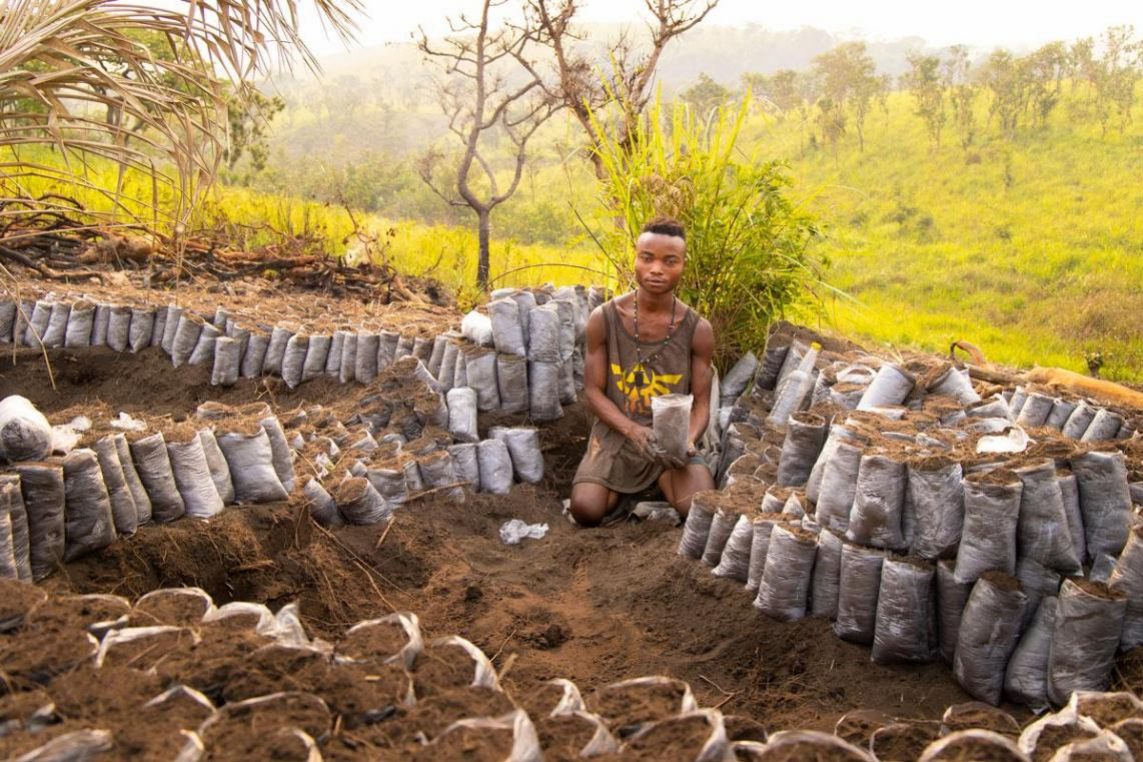
In one of the pepinières, we meet 145 people who are bagging tiny saplings from the nursery beds, then transplanting them into the nursery.
© Bart Lasuy
MO* journalist John Vandaele travelled to Congo to visit NGO Faja Lobi, which was started ten years ago by Jurgen Heytens from Ghent. With many small donations, the organisation planted 3,000 hectares of forest in the savannahs of Kwilu and became the largest employer in the region. It is a search for a development path that brings prosperity, while leaving the forest intact.
Translation of this article is provided by Kompreno, using a combination of machine translation and human correction. More articles from MO* are included in Kompreno‘s curation of the finest analysis, opinion & reporting — from all across Europe, translated into your language. Original source
The dilapidated jeep toils for nine hours on the 120 kilometres from Kikwit to the town of Idiofa, which has a population of about 150,000. As we threaten to get stuck in the sand for the umpteenth time, we wonder where Jurgen Heytens finds the courage and energy to travel this bad road countless times. Ten years ago, the man from Ghent founded the NGO Faja Lobi with the profits from his eponymous restaurant in Ghent. Its aim: to get a Congolese forestry project off the ground.
It is ten o’clock in the evening and pitch-dark when we finally reach Idiofa. The welcome at the Faja Lobi office is warm. We eat together on the terrace of the second floor of the brand-new building. In the dark, we cannot see the surroundings. Now and then a monkey jumps out of the trees onto the terrace, hoping for a banana or any other treat. They are quite assertive.
Chénilles
The big surprise follows the next morning, when we look through the window and see nothing but forest. Green forests as far as the eye can see.
‘770 hectares’, Heytens explains. From the forest, many raving voices echo. It later emerges that hundreds of children, young people and women are there feasting on the forest’s chénilles, the protein-rich caterpillars that are a popular delicacy in Congo. This is the first time these forests, near the town of Idiofa, have yielded chénilles so abundantly. The people are all too happy about it.
When we explore the area and the forests later that day, many dozens of caterpillar pickers show us their ‘harvest’ exuberantly. And each time the name Jurgen resounds. Or rather, ‘Jurguèn, jurguèn,…’
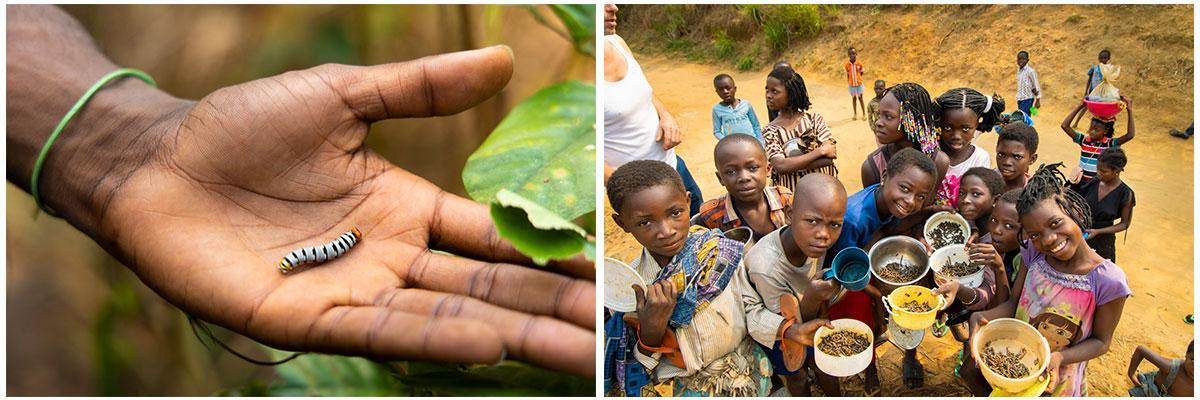
The ‘chénilles’, protein-rich caterpillars, are a popular delicacy in Congo.
© Bart Lasuy
People are grateful to him for the supermarket of proteins, but more importantly for making Faja Lobi just about the most important employer in the region. ‘He saved lives of the young people here; otherwise they would have become just little bandits anyway,’ says Norbert Ontshas, a retired civil servant.
We also bump into the so-called chacals, the jackals or forest guards. They see to it that the forests are respected, that no wood is cut or fire is played with. In this dry season, fire is a real danger, requiring maintenance, wide firebreaks, and vigilance to prevent it.
One of the chacals wears a uniform of the OCMW of Moorslede, the Ghent hospital Jan Palfijn, or the Rescuers of the Coast of Koksijde. ‘They wanted some kind of uniform,’ Heytens explains. ‘We got those for free from Flanders.’
‘On average, 70% of our spending ends up with local people.’
For years, Heytens scraped together small amounts of money and support everywhere to keep the project running and the people working. ‘All in all, it must be around 2 million euros by now. And on average, 70% of our spending ends up with the local population.’
The NGO employed some 700 day labourers on average last year; this year it is already 1,400 people, at $2.5 a day plus a meal, and has 110 people in permanent employment. Heytens: ‘For the day labourers, we negotiated with the Ministry of Labour that they can work longer than 20 days for us, as the day labourer status provides. That way they also have more income security. Because to give a future is to create stability.’
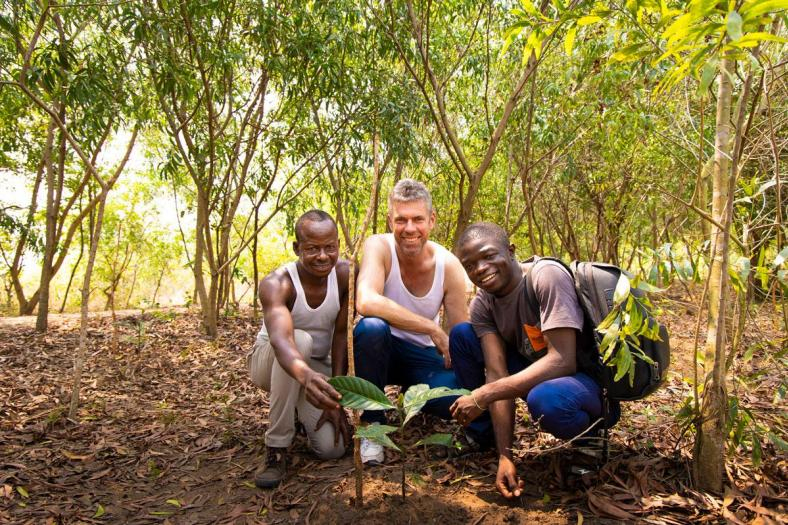
Jurgen Heytens: ‘Better agriculture should give the population a better structural income, without having to cut down forests.’
© Bart Lasuy
Stability through forestry
Later, as we walk through town, a man shouts from afar: ‘Jurguén!’ Afterwards, he recounts how two years ago this man stood with him on the street and argued for his release. He had been detained for alleged tax evasion.
And the man reaffirms what so many have already said: ‘Jurgen gives work to our young people.’ The fact that Heytens speaks the local language, lived in a modest hut for years and has been here, dedicated to Idiofa for 10 years undoubtedly increases his credibility.
However, Heytens did not come to Congo primarily to employ people. He wanted to plant trees, or even large forests, as a remedy to climate change. After all, with the same financial resources it is possible to build much more forest in Congo than in Western Europe.
‘In Ghent, I had a Congolese neighbour, Annie, whose brother lived in Idiofa, which I then visited. This seemed like an interesting location. It is a medium-sized town in an area of virtually treeless savannah. Because it is not far from the forest, there is also a bit more rainfall and there was an opportunity to connect with the forest through reforestation.’
Idofa’s territory covers 20,000 square kilometres, or two-thirds the area of Belgium. During the last 40 years, 240,000 hectares of forest were cut down. Faja Lobi, meanwhile, planted another 3,000 hectares of forest. But how does one embark on such a project?
‘Did you know that young people are now returning from Idiofa to Makanga village, 50 kilometres from here, because they can work at Faja Lobi?’
Initially, it was not obvious for Heytens. ‘The rumour went around that the white one came to look for diamonds in the area,’ said journalist Rigobert of community radio Nsemo (Light). ‘Nobody really believed that he wanted to plant trees and that we would benefit from that.’
Today, the radio station enjoys working with Faja Lobi because it contributes to development, he stresses. ‘Did you know that young people are now returning from Idiofa to the village of Makanga, 50 kilometres away, because they can work at Faja Lobi? Forestry provides stability.’ The initial distrust has turned into enthusiasm.
Heytens spoke to several clans and asked them if he could get a concession on some of their land. The clans have immense areas of savannah land that they do little else with. Then a concession fee of $25 per hectare for 25 years is not an unattractive sum in the Congolese interior.
Makanga, a village close to Idiofa, gave 900 hectares to Faja Lobi, generating $22,500 for the village. Heytens is also encouraging villagers to invest that capital injection in housing or schools.
Meanwhile, people are pushing to work with Faja Lobi. When we break down with the jeep on the way to Makanga, a woman briefly accosts us. ‘Why doesn’t Jurguén come to Inswe? Then he can give us work here too.’
Arriving in Makanga, the children storm towards us. ‘Jurguèn kélé, Jurgen is here,’ they chant. It has something almost messianic about it. In Makanga, two agronomists come to offer their services.
It is not only the capital injection through the concessions that benefits the locals. Faja Lobi also constructed three large tree nurseries in Makanga, which provided employment. On the 900 hectares, Faja Lobi planted acacias, but also many local tree species such as wenge, osing, ricodendron, owes, ontang, afromosio, iroko, hevea and so on. The seeds come from the jungle, where seed seekers look for indigenous tree species that are then planted here. Thus, the forest re-conquers the savannah.
Support
In one of the pepinières, plant nurseries, we meet 145 people who are bagging up tiny saplings from the nursery beds, in order to transplant them into the nursery. Immense areas are already being ploughed over where the trees will be planted, once the rainy season begins.
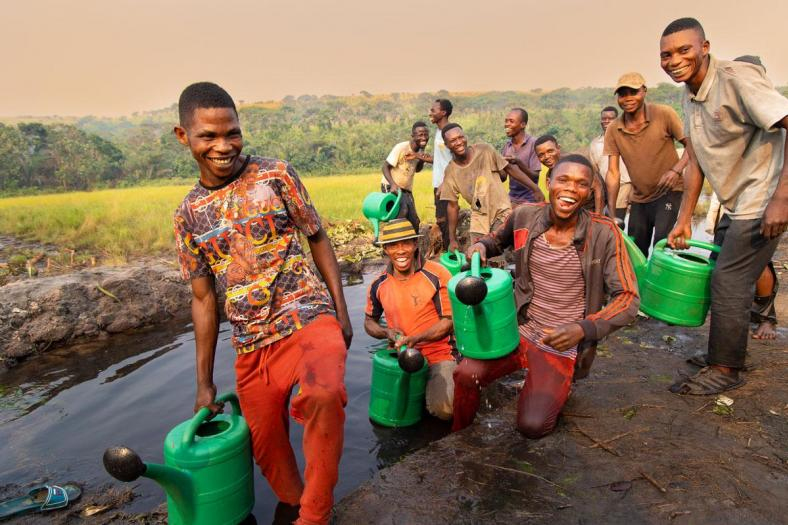
In one of the pepinières, we meet 145 people who are bagging tiny saplings from the nursery beds, then transplanting them into the nursery.
© Bart Lasuy
Fortunately, Faja Lobi has some tractors, ploughs, and a trailer that will allow the land to be prepared for planting more quickly. They are there thanks to mandates from Colruyt and funds from Mastercard’s World Resources Institute (through which it is investing $2 million in the creation of 1,000 hectares of biodiverse forest with social support). Yet some of the land is still cultivated manually.
On 400 hectares, Faja Lobi will plant fast-growing acacia and wenge, combined with improved cassava and other food crops. The population will receive free planting material for this. It is a combination that works well because acacia and wenge brings nitrogen into the soil, which promotes the growth of cassava.
But the forests planted by Faja Lobi are aimed at nature restoration, not agriculture. Only the first few years can agriculture be done in combination. There will be too little light left for the cassava plants after harvest, because the trees will grow quickly.
‘Eventually, we do foresee land where permanent forest agriculture can be done and where the wenge and acacia will be cut for charcoal every seven years. This will then make room for cassava over and over again,’ Heytens explains.
‘Better agriculture should give the population a better structural income without having to cut down forests.’
‘With green manures and trees, we can make the land more fertile faster, so Congo can produce more food on the same agricultural surface. Better agriculture should give the population a better structural income without having to cut down forests. We are looking for ways in which this can be done. We deliberately focus not on one village, but on several villages, so that there will always be enough land for agriculture besides our forests.’
Heytens realises that the forests he is planting will not last as long as there is no support from the local population. For that reason, Faja Lobi created an information centre. For a modest sum, computer science students can use the computers that most schools lack.
Faja Lobi also provides scholarships to students. It set up a small hospital in Idiofa and four medical centres in the villages, in addition to a café with a terrace, a sewing workshop where students can use sewing machines, and even a recording studio where young people can record music and videos.
In the forests it is planting, Faja Lobi provides rubber trees and mango trees along the roads, from which the population is allowed to reap the benefits. ‘If a cyclist has a flat tyre, he can repair it with the latex from the tree,’ says Faja Lobi.
The NGO also makes its own furniture, thanks to a carpentry workshop, with a construction department. Faja Lobi’s new office was largely built by its own staff after the previous office burned down.
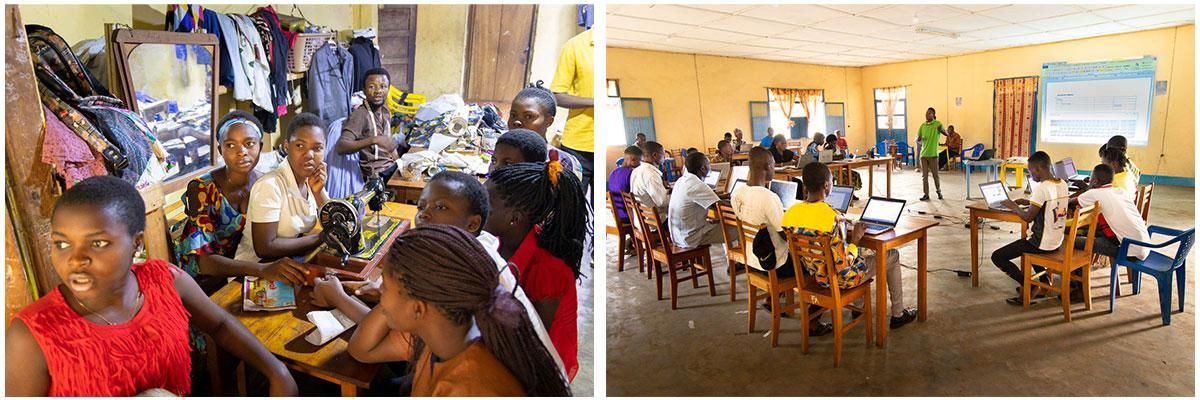
Faja Lobi also set up an information centre where computer science students can work on computers and a sewing workshop where students can practise cutting and threading on sewing machines.
© Bart Lasuy
Carbon credit
Moreover, the clans, whose lands were given to Faja Lobi in concession for $25, are also structurally involved in the operation of the project. Through the concession, they become members of the non-profit organisation, giving them a say in the future revenues from the forests, whether it comes from carbon credit or timber. This in turn does not apply to clans who charge more for a concession.
In addition to concessionaires, founding statutory members (including some Belgians) and employees are also part of the NPO. ‘It is a matter of finding a balance between forestry and the interests of the population,’ Heytens said.
The importance of that balance became clear to him 10 years ago. Then, after an initial four-month working period, he briefly moved to Belgium, and it turned out that his then Congolese manager was trying to expel him from the organisation. ‘Fortunately, the concessions were in my name, otherwise we would have lost everything,’ he says.
Because employees, concessionaires and the founding members are in the non-profit organisation, that would not be possible now. Heytens realises that the organisation should not depend on one person. He is therefore working on building a strong local team. ‘In time, I want to act as a mentor.’
This year, another 1,500 hectares should be added on top of the 3,000 hectares already planted. Together with CO2 Logic, which specialises in calculating, reducing and offsetting CO2 emissions, Faja Lobi is figuring out how to cash in on realised carbon credits.
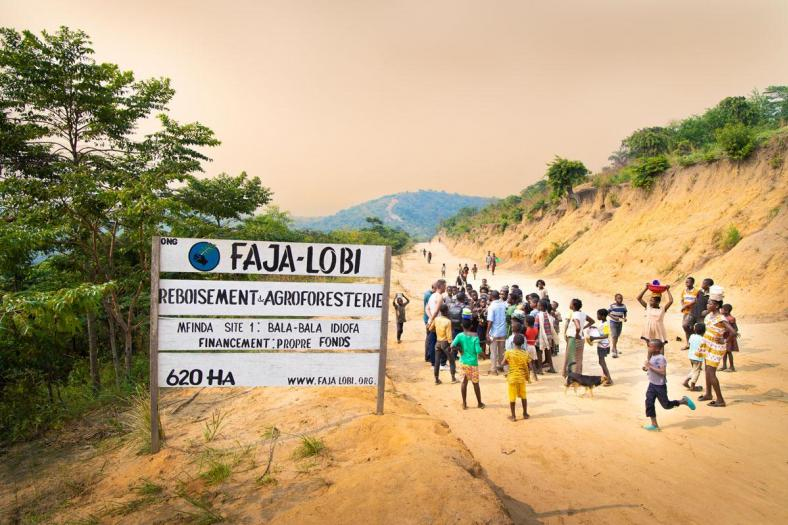
© Bart Lasuy
But the old forest burns…
As we travel 40 kilometres east on three finicky Chinese motorbikes, we increasingly enter areas where there is still more or less intact forest. More and more patches of forest pop up that are on fire or already charred.
‘If we don’t cut down, how can we grow groundnuts? Bring us an employer and we will stop felling.’
One man is busy expertly setting fire to a last large log. ‘I kill the forest,’ says Haricot N’gal. ‘God gave us the forest so we can eat.’
Further on, on the way to the village of Silankwilu, we start talking to some young people sitting together under the village parasol. ‘We cut down trees because we have no occupation. The only employer here is the village school. If we don’t cut down, how can we grow groundnuts? Bring us an employer and we will stop felling,’ says Itonno Kwenpa.
It is a stark contrast: 40 kilometres back, Faja Lobi is doing reforestation, while here the forest is being cut down. ‘Those are forests that are being manufactured,’ sounds the reply when asked why those forests are not being cut down. ‘We have to respect those. But our forests are a gift from the gods to us.’
Climate change does not seem to be an issue here. A little further on, people on the Lubwer River can be seen making pirogues, small canoe boats, and transport boats, which can be used to transport food to Kinshasa.
So, does jungle have to be cut down before there is money to reforest? Heytens also sees the paradox. ‘These villagers are not asking us to come to Silankwilu. It is about searching for the right approach. It is about searching for a balance between support to enrich agriculture, with additional crops, and our demand to leave the forest intact. Because Congo needs a lot of agriculture. If we replace agriculture only with forestry, you will only accelerate deforestation elsewhere.’
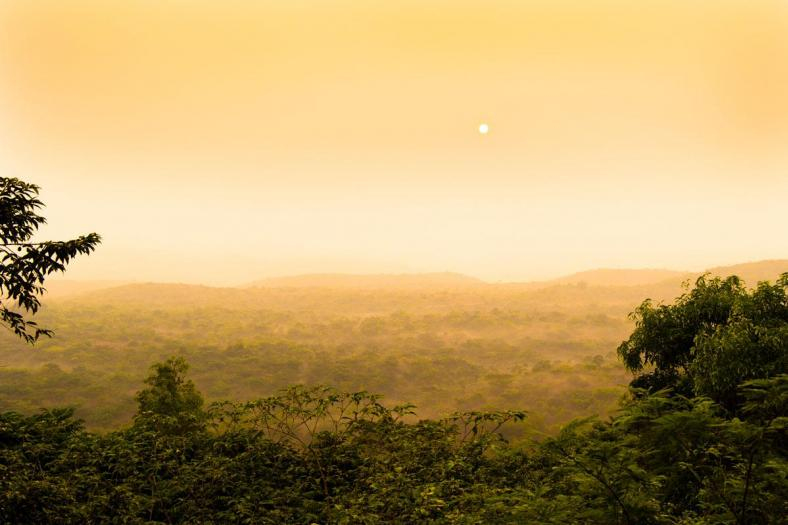
© Bart Lasuy
 This reportage was produced with the support of the Pascal Decroos Fund for Special Journalism.
This reportage was produced with the support of the Pascal Decroos Fund for Special Journalism.
Maak MO* mee mogelijk.
Word proMO* net als 2790 andere lezers en maak MO* mee mogelijk. Zo blijven al onze verhalen gratis online beschikbaar voor iédereen.
Meer verhalen
-
Report
-
Report
-
Report
-
Interview
-
Analysis
-
Report










 Oxfam België
Oxfam België Handicap International
Handicap International